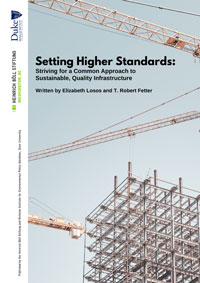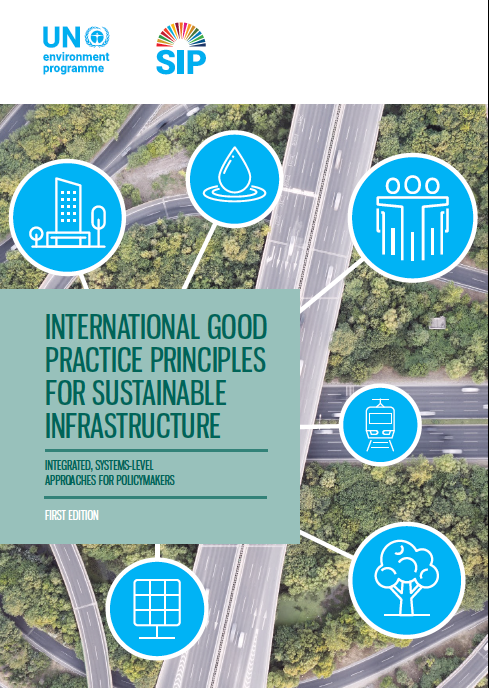Publications
Developing Key Performance Indicators for Climate Change Adaptation and Resilience Planning
This document from the Resilience Roadmap project recommends a common approach to developing key performance indicators (KPIs) for climate change adaptation and resilience planning, drawing upon current science and tools referenced throughout. The work is particularly aimed to support climate adaptation and resilience planning by US federal agencies and thus presents principally US national-level data and online resources. The approach is broadly applicable across agencies, sectors, and systems and can also be applied by state or local planners and adaptation/resilience practitioners.
Building a Common Approach: Global Infrastructure Standards
Well-planned, -designed, and -built infrastructure projects are critically needed to improve economic productivity, transition to a low-carbon economy, mitigate environmental risks, and promote human rights and social inclusion. Investors lack a reliable, widely recognized global standard for identifying “bankable” infrastructure projects with low environmental, social, and governance risks; high debt transparency; and reliable economic returns. A new report compares three sets of standards under development and offers recommendations to reduce confusion and advance a common approach.
Setting Higher Standards: Striving for a Common Approach to Sustainable, Quality Infrastructure
A barrier to the development of high-quality, sustainable infrastructure is the lack of a global standard for identifying projects with low environmental, social, and governance risks; high debt transparency; and reliable economic returns. This policy brief focuses on two new initiatives being developed to meet this need—Blue Dot Network and FAST-Infra—and offers recommendations to reduce competition between them and promote the broadscale advancement of quality, sustainable infrastructure.
Infrastructure Investment Must Incorporate Nature’s Lessons in a Rapidly Changing World
The authors of this commentary in One Earth suggest that infrastructure must become more resilient as the global climate changes and also more affordable in the economic and political context of a post-COVID world, and that we can solve this dual challenge and drive global infrastructure investment into a more sustainable direction by taking our cues from Nature.
Climate Policy Impacts on Building Energy Use, Emissions, and Health: New York City Local Law 97
This study in Energy uses several models and regulatory datasets to build novel NYC building energy use and GHG emission profiles based on New York City’s local law 97 and to investigate the impacts of LL97 on energy, climate, and health. The findings demonstrate the necessity of including health in energy and climate policy design.
The Environmental Implications of China-Africa Resource-Financed Infrastructure Agreements: Lessons Learned from Ghana’s Sinohydro Agreement
This case study assesses the environmental and social risks of the aluminum industry projects linked to the Sinohydro Agreement concluded in 2018 between the Government of Ghana and the Sinohydro Corporation, a Chinese state-owned enterprise specializing in infrastructure development.
International Good Practice Principles for Sustainable Infrastructure
The International Good Practice Principles for Sustainable Infrastructure set out ten guiding principles that policymakers can follow to help integrate sustainability into infrastructure planning and delivery. They are focused on integrated approaches and systems-level interventions that governments can make to create an enabling environment for sustainable infrastructure.
Concept Note for Sustainable Infrastructure Community of Learners
To aid economic recovery following the COVID-19 pandemic, new funding is being pledged globally to support infrastructure construction. Such investments by themselves, however, will not necessarily promote sustainable development. An opportunity exists to significantly accelerate the adoption of sustainable infrastructure (SI) by taking advantage of the recent proliferation of capacity development programs and tools. One key to achieving this transformation is the establishment of a learning community among SI capacity resource providers and SI capacity resource clients.
Graphical Models and the Challenge of Evidence-Based Practice in Development and Sustainability
In development and sustainability, evidence spans disciplines and methodological traditions and is often inconclusive. Graphical models are widely promoted to organize interdisciplinary evidence and improve decision-making by considering mediating variables. However, the reproducibility, objectivity and benefits for decision-making of graphical models have not been studied. In this paper, the authors evaluate these considerations in the setting of energy services in the developing world, a contemporary development and sustainability imperative.
Reducing Environmental Risks from Belt and Road Initiative Investments in Transportation Infrastructure
The proposed Belt and Road Initiative rail and road investments have stimulated concerns because of the history of significant negative environmental impacts from large-scale transportation projects across the globe. This paper studies environmental risks—direct and indirect—from Belt and Road Initiative transportation projects and the mitigation strategies and policies to address them. The paper concludes with a recommendation on how to take advantage of the scale of the Belt and Road Initiative to address these concerns in a way not typically available to stand-alone projects.










